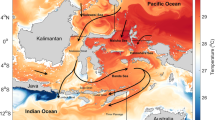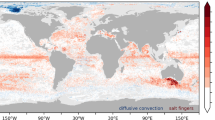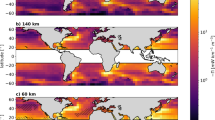Abstract
Mixing of water masses from the deep ocean to the layers above can be estimated from considerations of continuity in the global ocean overturning circulation1,2,3. But averaged over ocean basins, diffusivity has been observed to be too small4,5,6,7,8,9,10,11,12 to account for the global upward flux of water, and high mixing intensities have only been found in the restricted areas close to sills and narrow gaps10,11,13,14,15. Here we present observations from the Scotia Sea, a deep ocean basin between the Antarctic peninsula and the tip of South America, showing a high intensity of mixing that is unprecedented over such a large area. Using a budget calculation over the whole basin, we find a diffusivity of (39 ± 10) × 104 m2 s-1, averaged over an area of 7 × 105 km2. The Scotia Sea is a basin with a rough topography16, situated just east of the Drake passage where the strong flow of the Antarctic Circumpolar Current is constricted in width. The high basin-wide mixing intensity in this area of the Southern Ocean may help resolve the question of where the abyssal water masses are mixed towards the surface.
This is a preview of subscription content, access via your institution
Access options
Subscribe to this journal
Receive 51 print issues and online access
$199.00 per year
only $3.90 per issue
Buy this article
- Purchase on Springer Link
- Instant access to full article PDF
Prices may be subject to local taxes which are calculated during checkout


Similar content being viewed by others
References
Munk, W. H. Abyssal recipes. Deep-Sea Res. 13, 207–230 (1966).
Munk, W. H. & Wunsch, C. Abyssal recipes II: energetics of tidal and wind mixing. Deep-Sea Res. I 45, 1997–2010 (1998).
Toole, J. M. & McDougall, T. J. in Ocean Circulation and Climate (eds Siedler, G., Church, J. & Gould, J.) 337–355 (Academic, London, 2001).
Toole, J. M., Polzin, K. L. & Schmitt, R. W. Estimates of diapycnal mixing in the abyssal ocean. Science 264, 1120–1123 (1994).
Whitehead, J. A. & Worthington, L. V. The flux and mixing rates of Antarctic Bottom Water within the North Atlantic. J. Geophys. Res. 87, 7903–7924 (1982).
Hogg, N. G., Biscaye, P., Gardner, W. & Schmitz, W. J. On the transport and modification of Antarctic Bottom water in the Vema Channel. J. Mar. Res. 40 (suppl.), 231–263 (1982).
Saunders, P. M. Flow through Discovery gap. J. Phys. Oceanogr. 17, 631–643 (1987).
Barton, E. D. & Hill, A. E. Abyssal flow through the Amirante Trench (Western Indian Ocean). Deep-Sea Res. A 36, 1121–1126 (1989).
Durrieu de Madron, X. & Weatherly, G. Circulation, transport and bottom boundary layers of the deep currents in the Brazil Basin. J. Mar. Res. 52, 583–638 (1994).
Roemmich, D., Huatala, S. & Rudnick, D. Northward abyssal transport through the Samoan Passage and adjacent regions. J. Geophys. Res. 101, 14039–14055 (1996).
McCarthy, M. C., Talley, L. D. & Baringer, M. O. Deep upwelling and diffusivity in the southern Central Indian Basin. Geophys. Res. Lett. 24, 2801–2804 (1997).
Morris, M. Y., Hall, M. M., St Laurent, L. C. & Hogg, N. G. Abyssal mixing in the Brazil Basin. J. Phys. Oceanogr. 31, 3331–3348 (2001).
Polzin, K. L., Speer, K. G., Toole, J. M. & Schmitt, R. W. Intense mixing of Antarctic Bottom Water in the equatorial Atlantic Ocean. Nature 380, 54–57 (1996).
Polzin, K. L., Toole, J. M., Ledwell, J. R. & Schmitt, R. W. Spatial variability of turbulent mixing in the abyssal ocean. Science 276, 93–96 (1997).
Ledwell, J. R. et al. Evidence for enhanced mixing over rough topography in the abyssal ocean. Nature 403, 179–182 (2000).
Smith, W. H. F. & Sandwell, D. T. Global sea floor topography from satellite altimetry nd ship depth soundings. Science 277, 1956–1962 (1997).
Huang, R. X. Mixing and energetics of the oceanic thermohaline circulation. J. Phys. Oceanogr. 29, 727–746 (1999).
Zhang, J., Schmitt, R. W. & Huang, R. X. The relative influence of diapycnal mixing and hydrologic forcing on the stability of the thermohaline circulation. J. Phys. Oceanogr. 29, 1096–1108 (1999).
Ganachaud, A. & Wunsch, C. Improved estimates of global ocean circulation, heat transport and mixing from hydrographic data. Nature 408, 453–457 (2000).
Webb, D. J. & Suginobara, N. Vertical mixing in the ocean. Nature 409, 37 (2001).
Naveira Garabato, A. C., Heywood, K. J. & Stevens, D. P. Modification and pathways of Southern Ocean deep waters in the Scotia Sea. Deep-Sea Res. I (in the press).
Jackett, D. R. & McDougall, T. J. A neutral density variable for the world's oceans. J. Phys. Oceanogr. 27, 237–263 (1997).
Naveira Garabato, A. C., McDonagh, E. L., Stevens, D. P., Heywood, K. J. & Sanders, R. J. On the export of Antarctic Bottom Water from the Weddell Sea. Deep-Sea Res. II (2002).
Arhan, M., Heywood, K. J. & King, B. A. The deep waters from the Southern Ocean at the entry to the Argentine Basin. Deep-Sea Res. II 46, 475–499 (1999).
Orsi, A. H., Johnson, G. C. & Bullister, J. L. Circulation, mixing and production of Antarctic Bottom Water. Prog. Oceanogr. 43, 55–109 (1999).
Egbert, G. D. & Ray, R. D. Significant dissipation of tidal energy in the deep ocean inferred from satellite altimeter data. Nature 405, 775–778 (2000).
Sjoberg, B. & Stigebrandt, A. Computations of the geographical distribution of the energy flux to mixing processes via internal tide and the associated vertical circulation in the ocean. Deep-Sea Res. 39, 269–291 (1992).
Bell, T. H. Topographically-generated internal waves in the open ocean. J. Geophys. Res. 80, 320–327 (1975).
Fukumori, I., Raghunath, R. & Fu, L.-L. Nature of global large-scale sea level variability in relation to atmospheric forcing: a modelling study. J. Geophys. Res. 103, 5493–5512 (1998).
Olbers, D., Gouretski, V., Seiss, G. & Schroter, J. Hydrographic Atlas of the Southern Ocean (Alfred Wegener Inst. for Polar and Marine Res., Bremerhaven, Germany, 1992).
Acknowledgements
We thank P. Barker and F. Vine for discussions regarding the magnitude of geothermal heating in the Scotia Sea. ALBATROSS was funded by the Natural Environment Research Council.
Author information
Authors and Affiliations
Corresponding author
Ethics declarations
Competing interests
The authors declare no competing financial interests.
Rights and permissions
About this article
Cite this article
Heywood, K., Naveira Garabato, A. & Stevens, D. High mixing rates in the abyssal Southern Ocean. Nature 415, 1011–1014 (2002). https://doi.org/10.1038/4151011a
Received:
Accepted:
Issue Date:
DOI: https://doi.org/10.1038/4151011a
This article is cited by
-
Influence of two inlets of the Luzon overflow on the deep circulation in the northern South China Sea
Acta Oceanologica Sinica (2020)
-
Stabilization of dense Antarctic water supply to the Atlantic Ocean overturning circulation
Nature Climate Change (2019)
-
Modification of the deep salinity-maximum in the Southern Ocean by circulation in the Antarctic Circumpolar Current and the Weddell Gyre
Ocean Dynamics (2017)
-
Deep circulation driven by strong vertical mixing in the Timor Basin
Ocean Dynamics (2017)
-
Routes to energy dissipation for geostrophic flows in the Southern Ocean
Nature Geoscience (2013)
Comments
By submitting a comment you agree to abide by our Terms and Community Guidelines. If you find something abusive or that does not comply with our terms or guidelines please flag it as inappropriate.



